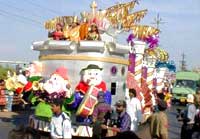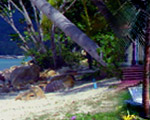|
Fairs & Festival
Throughout the year, every month, you will find fair and festival
of one kind or the other in Goa. These are mainly religious and
social in nature. But purely artistic festivals are also organized
such as Kala Academy's annual festivals, which draw artists and
art lovers from all over India.
The dates of religious festivals are decided according to respective
religious calendars. Some festivals like Shigmo and Carnival though
have religious origin, but with mass appeal have become the festivals
of the whole state and society. Some festivals are celebrated all
over Goa, while some take place at particular places.The observance
and celebration of feasts and festivals constitute the joyous aspect
of the religious life of the people.
Hindu Festivals
Chovoth or Ganesh Chaturthi
The most important and almost the national festival for Goan's is
the Ganesh Chaturthi known as 'Chovoth'. The festivities run into
several days, at least two and half days, when puja of Gouri and
Mahadev along with Ganapati, is performed, Gouri being drawn on
paper and Mahadev on a coconut. On these days married women fast.
On the Chovoth day, in the morning or evening, a clay idol of Ganapati
is brought home. Before that a matov (pa vilion
or pandal) is prepared with bunches of betel nut, coconut, bananas
and branches of mango-trees being necessary ingredients of it. The
puja of Ganapati goes on until mid-day. The puja is performed with
the help of the priest. vilion
or pandal) is prepared with bunches of betel nut, coconut, bananas
and branches of mango-trees being necessary ingredients of it. The
puja of Ganapati goes on until mid-day. The puja is performed with
the help of the priest.
On the second day, in the evening or at night, after performing
the uttara puja of the image of Ganapati, it is taken in procession
and immersed into the sea, creek, river, lake or well. Before the
idol is removed from its stand for immersion, it is besought for
the welfare of the household and its members.
Three days of Chovoth means, days of great rejoicing for children.
Girls collect different types and shapes of leaves for Gauri, Mahadev
and Ganapati. There is competition in flower-making also. At least
five vegetables are cooked on that day. Aartis is a special performance
on the occasion of the Ganapati festival.
On Panchami (fifth) day, in the evening, crowds of people move
around the village to have a look at Ganapati. Women of the masses,
dance and sing the Fugdi before Ganapati. Some houses keep Ganapati
for five, seven or nine days and rarely up to Anant Chaturdashi.
Dussera or Dosro
Dussera or Dosro in Konkani comes following the 'Navaratra' (nine
nights) and is celebrated in all the temples of Goa as a religious
ritual and an auspicious day for beginning any new venture. It is
celebrated on Vijayadashmi day. It is celebrated with pomp and ceremony
at the major temples of Goa, like Shri Shantadurga at Kavlem, Shri
Mangesh at Mangeshi, Shri Mahalsa at Mardol.
Diwali or Narak Chaturdasi
Following the Dosro, comes Diwali which is the festival of lights.
It is a one-day festival in Goa. Bhaubija and the New year day are
also celebrated as part of Diwali festival. Narak Chaturdasi is
called Diwali in Goa. On this day, early morning, a paper made Narkasur
(demon) filled with grass, wastepaper, crackers etc is taken out
and to the accompaniment of taunts and insults, burnt and cremated.
Later, in all the houses, bath is taken. Women prepare various types
of fov (dried beaten rice dusted with sugar or jaggery and wetted
lightly), raitas, usol and other snacks and serve them.
After the snacks are served, all men-folk are made obeisance to
by a gesture of showing a thali (plate) with lighted wicks around
their heads (onvalop) which is known as 'dive darkhovnk' in Konkani.
The men folk are expected to place some article or cash as a present
in this plate. Later after breaking a bitter gourd, crushed by the
finger of the left foot, it is applied to the tongue. Sweet snacks
are taken, after making obeisance to the God and the elders.
Shigmo
Shigmo is a social festival with a religious core. It is the Goan
counterpart of the Holi in the rest of India. On the Holi day, Puja
is performed of the stems of the teflam fruits or betel nut, struck
on the ground before the temple and a little grass put at their
feet is then burnt. There are a number of dances which burst forth
on this occasion in the spirit of plenty that marks the harvesting
season when the barns are full and a sense of satisfaction and mirth
is bubbling all around
Other Festivals
Gokulashtami, Mahashivratri and Brahmotsava are celebrated at the
temples of Goa with great splendor, when thousands of devotees from
all over Goa gather to pay homage to the deity. A famous fair known
as Jatra festival is held in the temple of goddess Lairai, situated
in the village of Sirigao in Bicholim taluka where thousands of
people from all over Goa come to pay their homage to the goddess.
A special feature of this Jatra is walking on burning coals by certain
devotees of the goddess popularly known as Dhonds. Top
Christian Festivals
The Goa Carnival
The most colorful and unforgettable festival of Goa The word Carnival
comes from the Latin 'Carnem levare' which literally means putting
away the flesh. History traces back the carnival celebrations to
the Saturnalia festival of the Romans. The most colourful and unforgettable
festival of Goa is the Carnival celebrated by the Catholics with
gay abandon once a year for three days preceding Lent- fro m
Sunday to Tuesday. During these three days, Goa is gripped by the
pulsating rhythm of guitars and the lilt of folk songs. The revelers
in their colourful improvised fancy dresses, dance and sing in the
streets, with King Momos, Lord of the Carnival, presiding over the
scene. m
Sunday to Tuesday. During these three days, Goa is gripped by the
pulsating rhythm of guitars and the lilt of folk songs. The revelers
in their colourful improvised fancy dresses, dance and sing in the
streets, with King Momos, Lord of the Carnival, presiding over the
scene.
Preparations for the Carnival starts in December and January. The
festival comes around February/March. Boys and girls plan and design
their fancy costumes for the occasion. They prepare packets and
cartridges made of paper and stuffed with bran, husk or sawdust
or plain powder.
Feast of St. Francis Xavier
The feast of saint Francis Xavier is held on 3rd December every
year at Velha Goa or Old Goa which is about 10kms east of Panaji.
The mummified body of St. Francis Xavier is enshrined in a silver
casket in one of the chapels of Basilica of Born Jesus built in
1605 by the Jesuits.
The body of the Saint is exposed to public once every ten years
and pilgrims from all over the world came to pay homage.
Feast of St. Francis Xavier
The feast of saint Francis Xavier is held on 3rd December every
year at Velha Goa or Old Goa which is about 10kms east of Panaji.
The mummified body of St. Francis Xavier is enshrined in a silver
casket in one of the chapels of Basilica of Born Jesus built in
1605 by the Jesuits.
The body of the Saint is exposed to public once every ten years
and pilgrims from all over the world came to pay homage.
Zatra at Cansaulin
Every year on the 6th day of January month, a remarkable Zatra is
held at Cansaulin near Margao to celebrate the arrival of the three
kings at Bethlehem. Three young men from different villages wear
wigs and gaudy garments and look like puppets. Then they climb to
a church located on a hillock near the village. Inside the church
is a carved infant Christ. Their entering the church is a signal
for the villagers to start merriment, dance and music. There are
fire-eating, fire walking feasts. This festival is observed with
gay abandon.
Feast of the Immaculate Conception
The religious feast of Immaculate Conception of our Lady (Mary)
is celebrated all over Goa on the 15th August. The date of this
ceremony differs from place to place in Goa, but the 15th August
is generally common to most parts of Goa. On that day the farmer
cuts the first ears of milk-filled corn from the rice-field and
presents them for God's blessing.
Ladainha or Ladin
Ladainha or Ladin is a thanksgiving ritual among the Christians
of Goa. The Ladin which literally means a litany to the Virgin Mary,
is a religious function of thanksgiving to god for material and
spiritual benefits that have accrued or are sought for, by the persons
sponsoring the Ladin. Preparations for Ladin would begin with the
purchase of grams, branco wine, candles, coloured tinsel paper in
the local market. The family altar is bedecked with flowers, creepers,
crotons laid out in vases. The gram soaked in water since morning
is then put on the fire to be boiled and coconut chips are sliced
to be mixed with the boiled grams. The Ladin consists of a litany
sung by every one present, to the accompaniment of the violin, singing
of hymns and prayers. The village choirmaster or a local violinist
conducts the show involved in the singing of the litany.
Muslim Festivals
Muharram, Bakrid and Ramzan are the festivals celebrated by the
Muslims in Goa.
The Final Word
The most popular public festivals are Carnival, Shigmo and Food
Festival.
Top
Info on Fairs and Festivals of Goa - india
|







 vilion
or pandal) is prepared with bunches of betel nut, coconut, bananas
and branches of mango-trees being necessary ingredients of it. The
puja of Ganapati goes on until mid-day. The puja is performed with
the help of the priest.
vilion
or pandal) is prepared with bunches of betel nut, coconut, bananas
and branches of mango-trees being necessary ingredients of it. The
puja of Ganapati goes on until mid-day. The puja is performed with
the help of the priest.  m
Sunday to Tuesday. During these three days, Goa is gripped by the
pulsating rhythm of guitars and the lilt of folk songs. The revelers
in their colourful improvised fancy dresses, dance and sing in the
streets, with King Momos, Lord of the Carnival, presiding over the
scene.
m
Sunday to Tuesday. During these three days, Goa is gripped by the
pulsating rhythm of guitars and the lilt of folk songs. The revelers
in their colourful improvised fancy dresses, dance and sing in the
streets, with King Momos, Lord of the Carnival, presiding over the
scene.